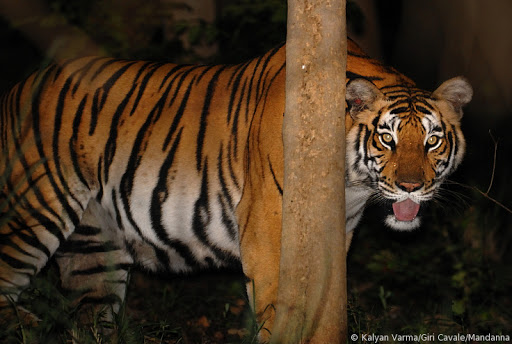Introduction
Published in the journal “Biological Conservation”, the authors K. Ullas Karanth, N. Samba Kumar, Krithi K. Karanth show that, based on the rise in the tiger population of Malenad in Karnataka, Kerala, and Tamil Nadu (where 10-15% of the tigers of India reside today) from 1970-2015, there is a potential for a larger number of tigers to inhabit the area. The authors articulate and analyze the tiger conservation methods of Malenad from 1986-2017 in order to inform their proposed methods to encourage tiger population growth.
Much of South/Southeast Asia has seen a decline, if not extirpation of tigers. Malenad, on the other hand, has grown from 70-291 in 45 years since the Wildlife Protection Act (WPA), development of reserves, and barring of hunting. The authors postulate that Malenad can support 300% of the current tiger population. The article recognizes the need for cultural and political support from the Indian public and public sector, including National Tiger Conservation Authority.
Early on in the study of tiger conservation, demographics were not given importance. After WPA, forestry officials began using the pugmark census method, which has been found to be flawed. By the 1960s, it was understood that the Malenad Tiger population was confined to 21,000 sq km, and the population had declined greatly.
The 1970s-1990s brought several legal resolutions for tigers throughout India. This, along with emerging economic opportunities outside the reserve regions in Karnataka, supported tiger population increase. The forest department also provided resettlement in order to protect wildlife.
Objectives
The researchers used data from the Malenad Tiger Program (MTP) to understand how the population could be enhanced. The MTP had 4 major objectives:
- To assess prey available through estimation of abundance of prey species.
- To assess the diet, prey selection behavior, prey killing and consumption rates of tigers. This can help predict the potential capacity of the region to handle tigers, as per the prey availability.
- “To estimate tiger densities and vital rates (such as survival and recruitment)” (3). It can be assumed that higher densities are more feasible to determine survival rates.
- To assess habitat occupancy of tigers at the landscape level from sign surveys, and determine approximate tiger abundance and population recovery.
This is a macroecological scale developed with integrating data from multiple sources.
The second major area of the study was understanding the relationship between predatory behavior and social organization of tigers, conducted in Nagarahole from 1986 - 1996. This covered two aspects:
- What are the tiger-prey relationships? The analysis was based on dietary patterns, prey selection and killing rates.
- The social organization within the tiger species, and in relation to Leopards and Dholes, who are not typically prey of tigers.
Methodology
Several methods of estimating tiger abundance were utilized. The most innovative seems to be the use of capture-recapture photography. Through this methodology, scientists surveyed tiger populations in seven wildlife reserves in Malenad in an area of over 6000 sq km and captured >8800 photo-captures of 900+ distinct tigers. This, combined with estimation of densities of principal prey species, tiger prey and non-prey social organization, estimation of tiger population density and abundances at source sites, and habitat occupancy patterns, allowed for multi-scale data collection and analysis. The outcome was an estimate of 391 tigers within four clusters (5).
Conservation research has included the following:
- Human impact on tigers and habitats: Tiger body parts sales in the 1990s contributed to the population decline. Another factor was local over-hunting. MTP built rapport with informants for clandestine knowledge about local hunts. The researchers theorize that such issues exist based on comparison of tiger populations in well-protected and less-protected reserve areas. An analysis of habitat fragmentation within reserves has been conducted. Such studies demonstrate that to develop tiger density requires legal protection and effective law enforcement to “curtail illegal hunting, reduce competition from livestock and impact on habitats from extractive pressures that emanate from human settlements” (6).
- Beyond research, MTP translated the science into activism, as “Science-based Conversation”. Several NGOs were trained to develop awareness, education, advocacy and legal action for tiger conservation.
- State Government Support: Karnataka TCP, with 14 allied organizations, collaborated from 1998-2001 to enhance the government’s mechanisms for protection of the tiger. This led to “strengthening law enforcement capabilities” through resource development, such as field-patrol vehicles, boats, wireless stations, vehicle-based and hand-held wireless sets; uniforms; gear; upskilling workshops; insurance coverage; and awards. Public awareness was raised through speaking opportunities, camps for youth, forest-fire awareness campaigns, and mass-media events. Government supported habitat protection through voluntary resettlement programs. (7)
- Human-Tiger conflicts have been partially resolved for the humans through financial assistance by the government. “The Wild Seve model of improving access to government schemes and collecting scientific data on human-wildlife conflict is scalable to high conflict regions globally, to the benefit of people and wildlife” (7).
- Wild Shaale project was designed to increase support and empathy in children traumatically affected by conflicts in their villages. The project was developed holistically to “increase environmental literacy, interest in and empathy for wildlife and wild spaces” among the children. The curriculum included “activities and games with defined learning objectives, in local languages based on local conservation issues”. Recognizing the wide variety of learning styles amongst the children, tools included “art projects, play-based learning and multimedia presentations” (7).
Discussion and Conclusion
The impact of MTP on tiger conservation is seen in two major categories:
- A new methodology for assessment of tiger population and habitats. Officials are hesitant to adopt such systems, even with the offer of training by the team.
- An understanding of the need for macroecological management and conservation of tigers to have purposeful or poignant allocation of funds, which is not happening at present.
Further research and programs are required. In addition, access and permissions for qualified wildlife scientists should be granted by the Ministries of Science & Technology at State and Central government levels, rather than forestry officials, who tend to push back research, often even taking legal measures to stymie progress.
“Malenad landscape can potentially support 1297 tigers, suggesting that the current tiger population is only at 30% of the landscape-level carrying capacity” (9). Management implications of this include:
- recovery efforts to be focused on wildlife reserves below their carrying capacities.
- effective law enforcement and resettlements are key interventions that increase prey and tiger densities
- Utilize practices which enhance preservation of natural plant and animal diversity.
In conclusion, despite fragmented habitats, tiger populations have recovered in regions of India with high human population densities, economic growth and development, “induced by advancing technology and demographic transition” (9); other reasons include “reductions in hunting of prey species, regulation of local access to forest product extraction, and in some cases, reduction of human impacts”.
MTP has been successful in curriculum and material development. It has also abundantly produced peer-reviewed journal articles and scientific book chapters, as well as technical reports.
(Feature image by Kalyan Varma)





